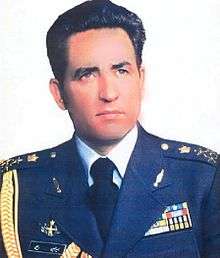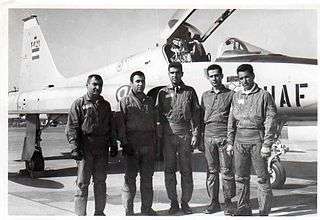Amir Hossein Rabii
Sepahbod Amir Hossein Rabii (Persian: امیرحسین ربیعی; 31 December 1930 – 9 April 1979) was an Iranian senior military officer who served as the commander in chief of Imperial Iranian Air Force from 1976 to 1979. He was the last commander of the force.[1]
Amir Hossein Rabii | |
|---|---|
 | |
| Native name | امیرحسین ربیعی |
| Born | 31 December 1930 Kermanshah, Iran |
| Died | 9 April 1979 (aged 48) Qasr Prison, Tehran, Iran |
| Buried | Behesht Zahra |
| Allegiance | Iran |
| Service/ | |
| Years of service | 1949–1979 |
| Rank | |
| Commands held | Chief of the Imperial Iranian Air Force (1976 - 1979) |
Education
Rabii was among the first military officers of the Imperial Iranian Air Force who were trained at the Furstenfeldbrook air base in Germany during the 1950s and later Reese Air Force Base in the United States.[2][3] He and other military officers including Nader Jahanbani also took jet pilot instructor course at the air base.[3]
Career and activities
Rabii was a fighter pilot on the F-86 Sabre and later the F-4 Phantom.[4][5] After returning to Iran he contributed to the foundation of the acrobat team in the air force, named the Imperial Iranian Air Force Golden Crown Acro Jet Team, in 1958.[3] He was the commander of the Tactical Air Command in Shiraz[6] until 1976.[7] He served as commander in chief of Imperial Iranian Air Force (IIAF) from Spring 1976 to 1979 with the rank of lieutenant general.[8] He succeeded Fazayel Tadayoun in the post.[8] When he was in command, there were forty-eight thousand men in the air force.[9] Barry Rubin, a veteran Middle East expert, described him as possibly "the most able officer in the top circles of the armed forces."[10]

In August 1978, Rabii indirectly urged Moshe Dayan, then foreign minister of Israel, to meet the Shah, Mohammad Reza Pahlavi, and to tell him the increasing tension in Iran.[11] Rabii complained that the Shah had been ignoring his and others' remarks.[11] The visit was paid by Dayan in the following days.[12]
Rabii was one of the military officials who met General Robert Huyser, then deputy commander of US forces in Europe, during the latter's visit to Iran from 4 January to 3 February 1979.[13][14] Three days before leaving the country on 13 January, the Shah told all commanders, including Rabii, that they should support the government of Shapour Bakhtiar.[15] Following the 1979 revolution clashes occurred between supporters of Ayatollah Khomeini and people loyal to the Shah regime. Rabi'i instructed his men not to kill anyone on the other side.[7] When then prime minister Bakhtiar ordered him to bomb the arms factory in central Tehran, he refused to carry out this order.[16][17] Rabii did not support for the revolution, but a significant portion of the air force cadets and young skilled military technical personnel did.[18] Sa'id Mehdiyun replaced Rabii as commander of the air force.[19]
Personal life
Rabii married a German woman, Gerda, and had two sons, Arean and Arman.[7]
Death
Rabii was arrested in February 1979 along with Tehran martial law governor Mehdi Rahimi, air force general Ayat Mahaghghi (Mohagheghi) and Isfahan martial law governor Reza Naji, and they were all taken to Alawi school in Tehran.[20] Special press conferences were organized by the Islamic regime to publicly display these officials, including former prime minister Amir-Abbas Hoveyda, former SAVAK chief Nematollah Nasiri and Rabii, and these conferences were broadcast nationally.[17] During the initial interrogations, Rabii stated that the air force purchased advanced warplanes and other military equipment from the US, which were all in the country, and that the air force of Iran was intact and the second powerful force in the world.[17]
Rabii was secretly tried[19] and in the court, he stated "General Huyser threw the Shah out of the country like a dead mouse."[21] He was sentenced to death on charges of corruption on earth and treason among the others.[22][23] Local dailies reported that the verdict was based on the confessions of other Shah-period officials.[22] He and nine other civil and military officials were executed by the security forces of the Islamic Republic of Iran in Qasr prison of Tehran on 9 April 1979.[4][24]
References
- Sepehr Zabir (23 April 2012). The Iranian Military in Revolution and War (RLE Iran D). CRC Press. p. 10. ISBN 978-1-136-81270-5. Retrieved 30 July 2013.
- "Military". The Iranian. November 2002. Archived from the original on 25 February 2014.
- "Golden Crown History". IIAF. Retrieved 31 July 2013.
- "Shah's air force chief executed". The Telegraph-Herald. Tehran. UPI. 9 April 1979. Retrieved 31 July 2013.
- "IIAF Personnel killed by Islamic Regime between 1979 - Present". Imperial Iranian Air Force. Retrieved 30 July 2013.
- "BIO Changes Concerning Amir Hossein Rabii". FOIA Reading Room Iran. 24 April 1975. Retrieved 3 February 2017.
- Solomon, Mary K. (25 April 1979). "Execution was a tragedy". The Deseret News. Retrieved 30 July 2013.
- "IIAF History". IIAF. Retrieved 30 July 2013.
- Kraft, Joseph (18 December 1978). "Letter from Iran". The New Yorker. Retrieved 30 July 2013.
- Rubin, Barry (1980). Paved with Good Intentions (PDF). New York: Penguin Books. p. 227. Archived from the original (PDF) on 21 October 2013.
- Ronen Bergman (9 September 2008). The Secret War with Iran: The 30-Year Clandestine Struggle against the World's Most Dangerous Terrorist Power. Simon & Schuster. p. 19. ISBN 978-1-4165-6490-4. Retrieved 30 July 2013.
- O’Sullivan, Arieh (2 February 2009). "Open Secrets (Extract)". The Jerusalem Post. Retrieved 30 July 2013.
- Jean-Charles Brotons (2010). U.S. Officials and the Fall of the Shah: Some Safe Contraction Interpretations. Lexington Books. p. 74. ISBN 978-0-7391-3340-8. Retrieved 31 July 2013.
- Andrew Scott Cooper (11 February 2015). "Declassified diplomacy: Washington's hesitant plans for a military coup in pre-revolution Iran". The Guardian. Retrieved 19 May 2016.
- Gholam Reza Afkhami (13 December 2008). The Life and Times of the Shah. University of California Press. p. 503. ISBN 978-0-520-94216-5. Retrieved 30 July 2013.
- Kadivar, Cyrus (March 2003). "History photos". The Iranian. Archived from the original on 27 April 2014. Retrieved 30 July 2013.
- "Former leaders facing charges". The Calgary Herald. Tehran. UPI. 14 February 1979. Retrieved 31 July 2013.
- "National security". Pars Times. Retrieved 24 August 2013.
- Roberts, Mark (January 1996). "Purge of the Monarchists". McNair Papers (47–48). Retrieved 29 August 2013. – via Questia (subscription required)
- "Revolution: 1979-1999". The Iranian. Archived from the original on 27 April 2014. Retrieved 30 July 2013.
- Amuzegar, Jahangi (1991). Dynamics of the Iranian Revolution: The Pahlavis' Triumph and Tragedy. State University of New York Press. p. 88. ISBN 978-0-7914-0731-8.
- "Law And Human Rights in the Islamic Republic of Iran" (PDF). Amnesty International. 13 March 1980. Archived from the original (Report) on 6 March 2016. Retrieved 3 August 2013.
- "One person's story. Mr. Amir Hosein Rabi'i". OMID. Retrieved 30 July 2013.
- "Firing squads kill 10 in Iran". The Dispatch. Tehran. AP. 9 April 1979. Retrieved 30 July 2013.